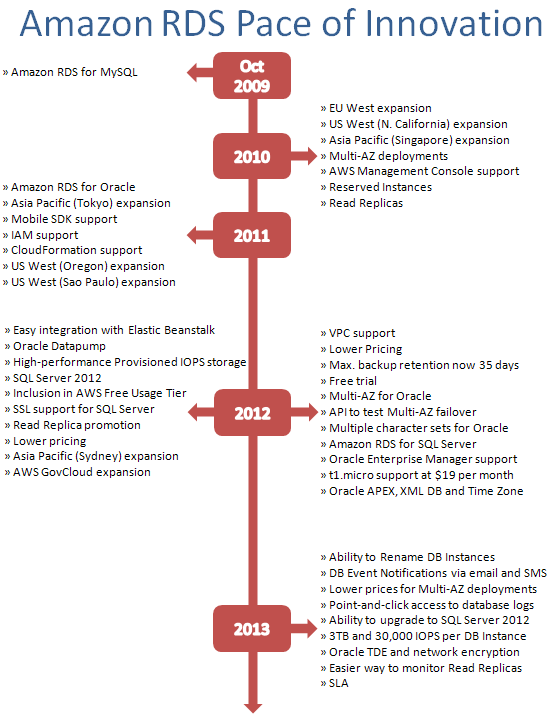AWS News Blog
Amazon RDS: 3.5 years, 3 Engines, 9 Regions, 50+ Features and Tens of Thousands of Customers
The Amazon Relational Database Service (RDS) was designed to simplify one of the most complex of all common IT activities: managing and scaling a relational database while providing fast, predictable performance and high availability.
RDS in Action
In the 3.5 years since we launched Amazon RDS, a lot has happened. Amazon RDS is now being used in mission-critical deployments by tens of thousands of businesses of all sizes. We now process trillions of I/O requests each month for these customers. We’re seeing strong adoption in enterprises such as Samsung and Unilever, web-scale applications like Flipboard and Airbnb, and large-scale organizations like NASA JPL and Obama for America.
RDS Innovation
We have added support for three major database engines (MySQL, Oracle, and SQL Server), expanded support to all nine of the AWS Regions, and added more than 50 highly requested features. Here is a timeline to give you a better idea of how many additions we have made to RDS since we launched it:

Let’s take a closer look at a few of the more important features on this timeline:
- Multiple Database Engines – Support for Oracle Database and Microsoft SQL Server in addition to MySQL.
- Multi-AZ Deployments – This feature enables you to create highly available database deployments with synchronous replication across Availability Zones, automatic failure detection and failover using just a few clicks on the AWS Management Console.
- Read Replicas – This feature makes it easy to elastically scale out beyond the capacity constraints of a single database instance for read-heavy database workloads. You can promote a Read Replica to a master as needed and monitor the replication status directly through the AWS Management Console.
- Provisioned IOPS – Amazon RDS Provisioned IOPS is a storage option designed to deliver fast, predictable, and consistent I/O performance, and is optimized for I/O-intensive, transactional (OLTP) database workloads. You can provision up to 3TB of storage and 30,000 IOPS per database instance.
- Point-and-click Access to Database Logs – You can view and download a variety of database log files to troubleshoot database issues directly using the AWS Management Console.
- DB Notifications via Email and SMS – You can subscribe to receive e-mail or SMS notifications when database events such as failover, low storage, replication state change, and so forth occur.
As I noted above, these innovations are powering some of the worlds most popular applications that are used by millions of users.
General Availability & The New RDS SLA
We’re marking Amazon RDS as “generally available” after adding the highly requested features described above.
With strong customer adoption across multiple market segments, numerous new features, and plenty of operational experience behind us, we now have a Service Level Agreement (SLA) for Amazon RDS, with 99.95% availability for Multi-AZ database instances on a monthly basis. This SLA is available for Amazon RDS for MySQL and Oracle database engines because both of those engines support Multi-AZ deployment. If availability falls below 99.95% for a Multi-AZ database instance (which is a maximum of 22 minutes of unavailability for each database instance per month), you will be eligible to receive service credits. The new Amazon RDS SLA is designed to give you additional confidence to run the most demanding and mission critical workloads dependably in the AWS cloud. You can learn more about the SLA for Amazon RDS at http://aws.amazon.com/rds-sla.
— Jeff;